Effect of Short-Term Zero Tillage and Legume Intercrops on Soil Quality, Agronomic and Physiological Aspects of Cotton under Arid Climate
Abstract
1. Introduction
2. Materials and Methods
2.1. Site Characteristics and Climatic Conditions
2.2. Experimental Details
2.3. Measurements and Analytical Procedures
2.3.1. Phenological, Physiological, and Yield Attributes of the Cotton Crop
2.3.2. Number of Pods Per Plant, Seed Yield, Biomass, and Harvest Index of Leguminous Intercrops
2.3.3. Determination of Soil Physicochemical Properties
2.3.4. Statistical Analysis
2.3.5. Economic Analysis and Assessment of System Productivity
3. Results
3.1. Phenological Attributes
3.2. Physiological Attributes
3.3. Yield and Yield-Related Attributes of the Cotton Crop
3.4. Yield and Yield-Related Attributes of Leguminous Intercrops
3.5. Soil Health Indicators
3.6. System Productivity
4. Discussion
5. Conclusions
Author Contributions
Funding
Institutional Review Board Statement
Informed Consent Statement
Data Availability Statement
Acknowledgments
Conflicts of Interest
References
- Shuli, F.; Jarwar, A.H.; Wang, X.; Wang, L.; Ma, Q. Overview of the Cotton in Pakistan and its Future Prospects. Pak. J. Agric. Res. 2018, 31, 396–407. [Google Scholar] [CrossRef]
- Ibrahim, N.A.; Moneim, N.M.A.; Halim, E.A.; Hosni, M.M. Pollution Prevention of Cotton-Cone Reactive Dyeing. J. Clean. Prod. 2008, 16, 1321–1326. [Google Scholar] [CrossRef]
- Government of Pakistan (GOP). Agriculture. In Economic Survey of Pakistan; Economic Advisory Wing, Ministry of Finance, Division: Islamabad, Pakistan, 2018; pp. 14–32. [Google Scholar]
- Abdullaev, I.; Hassan, M.U.; Jumaboev, K. Water Saving and Economic Impacts of Land Leveling: The Case Study of Cotton Production in Tajikistan. Irrig. Drain. Syst. 2007, 21, 251–263. [Google Scholar] [CrossRef]
- Khalid, M.Z.; Ahmed, S.; Al-Ashkar, I.; EL Sabagh, A.; Liu, L.; Zhong, G. Evaluation of Resistance Development in Bemisia Tabaci Genn. (Homoptera: Aleyrodidae) in Cotton against Different Insecticides. Insects 2021, 12, 996. [Google Scholar] [CrossRef] [PubMed]
- Farooq, O.; Mubeen, K.; Khan, A.A.; Ahmad, S. Sowing Methods for Cotton Production. In Cotton Production and Uses; Springer: Singapore, 2020; pp. 45–57. [Google Scholar]
- Das, A.; Yadav, G.; Lal, R. Legumes for Soil Health and Sustainable Management; Springer: Singapore, 2018; pp. 347–484. [Google Scholar]
- Ryken, N.; Nest, T.V.; Al-Barri, B.; Blake, W.; Taylor, A.; Bodé, S.; Ruysschaert, G.; Boeckx, P.; Verdoodt, A. Soil Erosion Rates under Different Tillage Practices in Central Belgium: New Perspectives from a Combined Approach of Rainfall Simulations and 7Be Measurements. Soil Tillage Res. 2018, 179, 29–37. [Google Scholar] [CrossRef]
- Nosrati, K.; Collins, M.; Adrian, L. A Soil Quality Index for Evaluation of Degradation under Land Use and Soil Erosion Categories in a Small Mountainous Catchment. Iran. J. Mt. Sci. 2019, 16, 2577–2590. [Google Scholar] [CrossRef]
- Zeraatpisheh, M.; Bakhshandeh, E.; Hosseini, M.; Alavi, S.M. Assessing the Effects of Deforestation and Intensive Agriculture on the Soil Quality through Digital Soil Mapping. Geoderma 2020, 363, 114–139. [Google Scholar] [CrossRef]
- Broman, G.I.; Robert, K.H. A Framework for Strategic Sustainable Development. J. Clean. Prod. 2017, 14, 17–31. [Google Scholar] [CrossRef]
- Busby, P.E.; Wagner, C.; Friesen, M.R.; Kremer, M.L.; Bennett, J.; Dangl, A. Research Priorities for Harnessing Plant Micro Biomes in Sustainable Agriculture. PLoS Biol. 2017, 15, 200–293. [Google Scholar] [CrossRef]
- Yadav, S.K.; Soni, R.; Rajput, A.S. Role of Microbes in Organic Farming for Sustainable Agro-Ecosystem. In Microorganisms for Green Revolution; Springer: Singapore, 2018; pp. 241–252. [Google Scholar]
- Jousset, A. Application of Protists to Improve Plant Growth in Sustainable Agriculture; Springer: Singapore, 2017; pp. 263–273. [Google Scholar]
- Singh, R.K.; Singh, A.K.; Singh, J.B.; Singh, L. Success of Zero Tillage Technology: A Case of Knowledge Management for Sustainable Agriculture. Ind. J. Extent. Educ. 2016, 12, 110–115. [Google Scholar]
- Bowers, C.; Toews, M.; Liu, Y.; Schmidt, J.M. Cover Crops Improve Early Season Natural Enemy Recruitment and Pest Management in Cotton Production. Biol. Cont. 2020, 141, 104149. [Google Scholar] [CrossRef]
- Sharma, P.; Singh, A.; Kahlon, C.S.; Brar, A.S.; Grover, K.; Dia, K.; Steiner, R.L. The Role of Cover Crops towards Sustainable Soil Health and Agriculture. A Review Paper. Am. J. Plant Sci. 2018, 9, 1935–1951. [Google Scholar] [CrossRef]
- Martin, G.; Paquette, A.; Dupras, A.; Rivest, D. The New Green Revolution: Sustainable Intensification of Agriculture by Intercropping. Sci. Total Environ. 2018, 615, 767–772. [Google Scholar] [CrossRef] [PubMed]
- Busari, M.A.; Kukal, S.S.; Kaur, A.; Bhatt, R.; Dulazi, A.A. Conservation Tillage Impacts on Soil, Crop and the Environment. Int. Soil Water Conserv. Res. 2015, 3, 119–129. [Google Scholar] [CrossRef]
- Bhatt, R. Zero Tillage Impacts on Soil Environment and Properties. J. Environ. Agric. Sci. 2017, 10, 1–19. [Google Scholar]
- Sayed, A.; Sarker, A.; Kim, J.E.; Rahman, M.; Mahmud, M.G.A. Environmental Sustainability and Water Productivity on Conservation Tillage of Irrigated Maize in Red Brown Terrace Soil of Bangladesh. J. Saudi Soc. Agric. Sci. 2020, 19, 276–284. [Google Scholar] [CrossRef]
- Duggan, L.; Yeates, J.; Stephen, A.; Greg, B. Bed Preparation Techniques and Herbicide Tolerance Technology for Tropical Dry Season Cotton Production. Trop. Agric. 2005, 82, 233–240. [Google Scholar]
- Page, K.L.; Dang, Y.P.; Dalal, R.C. The Ability of Conservation Agriculture to Conserve Soil Organic Carbon and the Subsequent Impact on Soil Physical, Chemical, and Biological Properties and Yield. Front. Sustain. Food Syst. 2020, 4, 31. [Google Scholar] [CrossRef]
- Saha, L.; Bauddh, K. Sustainable Agricultural Approaches for Enhanced Crop Productivity, Better Soil Health, and Improved Ecosystem Services. In Ecological and Practical Applications for Sustainable Agriculture; Springer: Singapore, 2020; pp. 1–23. [Google Scholar]
- Koishi, A.; Bragazza, L.; Maltas, A.; Guillaume, T.; Sinaj, S. Long-Term Effects of Organic Amendments on Soil Organic Matter Quantity and Quality in Conventional Cropping Systems in Switzerland. Agronomy 2020, 10, 1977. [Google Scholar] [CrossRef]
- Moran, P.J.; Greenberg, S.M. Winter Cover Crops and Vinegar for Early-Season Weed Control in Sustainable Cotton. J. Sustain. Agric. 2008, 32, 483–506. [Google Scholar] [CrossRef][Green Version]
- Brussaard, L.; Ruiter, P.C.; Brown, G.G. Soil Biodiversity for Agricultural Sustainability. Agric. Ecosyst. Environ. 2007, 121, 233–244. [Google Scholar] [CrossRef]
- Baritz, R.; Wiese, L.; Verbeke, I.; Vargas, R. Voluntary Guidelines for Sustainable Soil Management: Global Action for Healthy Soils. In International Yearbook of Soil Law and Policy 2017; Springer: Cham, Switzerland, 2018; pp. 17–36. [Google Scholar]
- Fustec, J.; Lesuffleur, F.; Mahieu, S.; Cliquet, J.B. Nitrogen Rhizodeposition of Legumes. A Review. Agron. Sustain. Dev. 2010, 30, 57–66. [Google Scholar] [CrossRef]
- Hauggaard-Nielsen, H.; Jornsgaard, B.; Kinane, J.; Jensen, E.S. Grain Legume-Cereal Intercropping: The Practical Application of Diversity, Competition and Facilitation in Arable and Organic Cropping Systems. Renew Agric. Food Syst. 2007, 23, 3–12. [Google Scholar] [CrossRef]
- Ghanbari, A.; Dahmardeh, M.; Siahsar, B.A.; Ramroudi, M. Effect of Maize-Cowpea (Vignaunguiculata, L.) Intercropping on Light Distribution, Soil Temperature and Soil Moisture in Arid Environment. J. Food Agric. Environ. 2010, 8, 102–108. [Google Scholar]
- Hauggaard, N.H.; Gooding, M.; Ambus, P.; Corre-Hellou, G.; Crozat, Y.; Dahlmann, C.; Dibet, A.; von Fragstein, P.; Pristeri, A.; Monti, M.; et al. Pea-Barley Intercropping for Efficient Symbiotic N2–Fixation, Soil N Acquisition and Use of Other Nutrients in European Organic Cropping Systems. Field Crop. Res. 2009, 113, 64–71. [Google Scholar] [CrossRef]
- Lithourgidis, A.S.; Dordas, C.A.; Damalas, C.A.; Vlachostergios, D.N. Annual Intercrops: An Alternative Pathway for Sustainable Agriculture. Aust. J. Crop. Sci. 2011, 5, 396–410. [Google Scholar]
- Chalka, M.K.; Nepalia, V. Nutrient Uptake Appraisal of Maize Intercropped with Legumes and Associated Weeds under the Influence of Weed Control. Indian J. Agric. Res. 2006, 40, 86–91. [Google Scholar]
- Srinivasarao, C.; Venkateswarlu, B.; Lal, R. Long-Term Effects of Soil Fertility Management on Carbon Sequestration in a Rice-Lentil Cropping System of the Indo-Gangetic Plains. Soil Sci. Soc. Am. J. 2012, 76, 167–178. [Google Scholar] [CrossRef]
- Lal, R. Restoring Soil Quality to Mitigate Soil Degradation. Sustainability 2015, 7, 5875–5895. [Google Scholar] [CrossRef]
- Walkley, A.; Black, I.A. An Examination of the Digestion Method for Determining Soil Organic Matter and a Proposed Modification of the Chromic Acid Titration Method. Soil Sci. 1934, 1, 29–38. [Google Scholar] [CrossRef]
- Subbaiah, V.V.; Asija, G.K. A Rapid Procedure for Utilization of Available Nitrogen in Soil. Curr. Sci. 1956, 26, 258–260. [Google Scholar]
- Olsen, S.R. Estimation of Available Phosphorus in Soils by Extraction with Sodium Bicarbonate; United States Department of Agriculture: Washington, DC, USA, 1954.
- Nelson, L.; Heidel, H. Soil Analysis Methods as Used in the Iowa State College Soil Testing Laboratory; Iowa State College, Agronomy Department: Ames, IA, USA, 1952. [Google Scholar]
- Steel, R.G.D.; Torrie, J.H.; Dickey, D.A. Principles and Procedures of Statistics: A Biometric Approach, 3rd ed.; McGraw Hill Book Co. Inc.: New York, NY, USA, 1997. [Google Scholar]
- Wang, X.B.; Cai, D.X.; Hoogmoed, W.B.; Oenema, O.; Perdok, U.D. Developments in Conservation Tillage in Rainfed Regions of North China. Soil Till. Res. 2007, 93, 239–250. [Google Scholar] [CrossRef]
- Layek, J.; Das, A.; Mitran, T.; Nath, C.; Meena, R.S.; Yadav, G.S.; Shivakumar, B.G.; Kumar, S.; Lal, R. Cereal + Legume Intercropping: An Option for Improving Productivity and Sustaining Soil Health. In Legumes for Soil Health and Sustainable Management; Springer: Singapore, 2018; pp. 347–386. [Google Scholar]
- Choudhary, R.; Singh, P.; Sidhu, H.S.; Nandal, D.P.; Jat, H.S.; Jat, M.L. Evaluation of Tillage and Crop Establishment Methods Integrated with Relay Seeding of Wheat and Mungbean for Sustainable Intensification of Cotton-Wheat System in South Asia. Field Crops Res. 2016, 199, 31–41. [Google Scholar] [CrossRef]
- Bessam, F.; Mrabet, R. Long-Term Changes in Soil Organic Matter under Conventional Tillage and No-Tillage Systems in Semiarid Morocco. Soil Use Manag. 2003, 19, 139–143. [Google Scholar] [CrossRef]
- Mitchell, J.; Shrestha, A.; Mathesius, K.; Scow, K.; Southard, R.; Haney, R.; Schmidt, R.; Munk, D.; Horwath, W. Cover Cropping, and no-Tillage Improve Soil Health in an Arid Irrigated Cropping System in California’s San Joaquin Valley, USA. Soil Tillage Res. 2017, 165, 325–335. [Google Scholar] [CrossRef]
- Bhatt, R.; Kukal, S. Delineating Soil Moisture Dynamics as Affected by Tillage in Wheat, Rice and Establishment Methods of Rice during Intervening Period. J. Appl. Nat. Sci. 2015, 7, 364–368. [Google Scholar] [CrossRef][Green Version]
- Qamar, R.; Ullah, E.; Saqib, M.; Javeed, H.M.R.; Rehman, A.; Ali, A. Influence of Tillage and Mulch on Soil Physical Properties and Wheat Yield in Rice-Wheat Systém. West Afr. J. Appl. Ecol. 2015, 23, 21–38. [Google Scholar]
- Nawar, A.I.; Fraihat, A.; Khalil, A.H.; El-Ela, A.M.A. Response of Faba Bean to Tillage Systems Different Regimes of NPK Fertilization and Plant Interspacing. Int. J. Agric. Biol. 2010, 12, 606–610. [Google Scholar]
- Bedoussac, L.; Justes, E. Dynamic Analysis of Competition and Complementarity for Light and Use to Understand the Yield and the Protein Content of a Durum Wheat-Winter Pea Intercrop. Plant. Soil. 2010, 330, 37–54. [Google Scholar] [CrossRef]
- Paul, B.K.; Vanlauwe, B.; Ayuke, F.; Gassner, A.; Hoogmoed, M.; Hurisso, T.T.; Pulleman, M.M. Medium-Term Impact of Tillage and Residue Management on Soil Aggregate Stability, Soil Carbon and Crop Productivity. Agric. Ecosyst. Environ. 2013, 164, 14–22. [Google Scholar] [CrossRef]
- Rajpoot, S.K.; Rana, D.S.; Choudhary, A.K. Bt-Cotton–Vegetable-Based Intercropping Systems as Influenced by Crop Establishment Method and Planting Geometry of Bt-Cotton in Indo-Gangetic Plains Region. Curr. Sci. 2018, 115, 516–522. [Google Scholar] [CrossRef]
- Rahman, M.H.; Ahmad, I.; Wang, D.; Fahad, S.; Afzal, M.; Ghaffar, A.; Saddique, Q.; Khan, M.A.; Saud, S.; Hassan, S.; et al. Influence of semi-arid environment on radiation use efficiency and other growth attributes of lentil crop. Environ. Sci. Pollut. Res. 2021, 28, 13697–13711. [Google Scholar] [CrossRef] [PubMed]
- Dhima, K.V.; Lithourgidis, A.S.; Vasilakoglou, I.B.; Dordas, C.A. Competition Indices of Common Vetch and Cereal Intercrops in Two Seeding Ratio. Field Crops Res. 2007, 100, 249–256. [Google Scholar] [CrossRef]
- Rahman, M.H.; Ahmad, A.; Wang, X.; Wajid, A.; Nasim, W.; Hussain, M.; Ahmad, B.; Ahmad, I.; Ali, Z.; Ishaque, W.; et al. Multi-Model Projections of Future Climate and Climate Change Impacts Uncertainty Assessment for Cotton Production in Pakistan. Agric. For. Meteorol. 2018, 253, 94–113. [Google Scholar] [CrossRef]
- Ahmad, S.; Ghaffar, A.; Rahman, M.H.U.; Hussain, I.; Iqbal, R.; Haider, G.; Khan, M.A.; Ikram, R.M.; Hussnain, H.; Bashir, M.S. Effect of Application of Biochar, Poultry and Farmyard Manures in Combination with Synthetic Fertilizers on Soil Fertility and Cotton Productivity under Arid Environment. Commun. Soil Sci. Plant Anal. 2021, 52, 2018–2031. [Google Scholar] [CrossRef]
- Rahman, M.H.; Ahmad, A.; Wajid, A.; Hussain, M.; Rasul, F.; Ishaque, W.; Islam, M.A.; Shelia, V.; Awais, M.; Ullah, A.; et al. Application of CSM-CROPGRO-Cotton Model for Cultivars and Optimum Planting Dates: Evaluation in Changing Semi-Arid Climate. Field Crop. Res. 2019, 238, 139–152. [Google Scholar] [CrossRef]
- Rahman, M.H.U.; Ahmad, A.; Wajid, A.; Akhtar, J.; Hoogenboom, G.; Hussain, M. Estimation of Temporal Variation Resilience in Cotton Varieties Using Statistical Models. Pak. J. Agric. Sci. 2016, 53, 787–807. [Google Scholar]
- Rahman, M.H.U.; Ahmad, I.; Ghaffar, A.; Haider, G.; Ahmad, B.; Tariq, M.; Nasim, W.; Rasul, G.; Fahad, S.; Ahmad, S.; et al. Climate Resilient Cotton Production System: A Case Study in Pakistan; Springer: Singapore, 2020; pp. 447–484. [Google Scholar] [CrossRef]
- Manzoor, S.; Habib-Ur-Rahman, M.; Haider, G.; Ghafoor, I.; Ahmad, S.; Afzal, M.; Nawaz, F.; Iqbal, R.; Yasin, M.; Haq, T.U.; et al. Biochar and Slow-Releasing Nitrogen Fertilizers Improved Growth, Nitrogen Use, Yield, and Fiber Quality of Cotton under Arid Climatic Conditions. Environ. Sci. Pollut. Res. 2021, 29, 13742–13755. [Google Scholar] [CrossRef]
- Majid, M.; Ali, M.; Shahzad, K.; Ahmad, F.; Ikram, R.M.; Ishtiaq, M.; Alaraidh, I.A.; Al-Hashimi, A.; Ali, H.M.; Zarei, T.; et al. Mitigation of Osmotic Stress in Cotton for the Improvement in Growth and Yield through Inoculation of Rhizobacteria and Phosphate Solubilizing Bacteria Coated Diammonium Phosphate. Sustainability 2020, 12, 10456. [Google Scholar] [CrossRef]
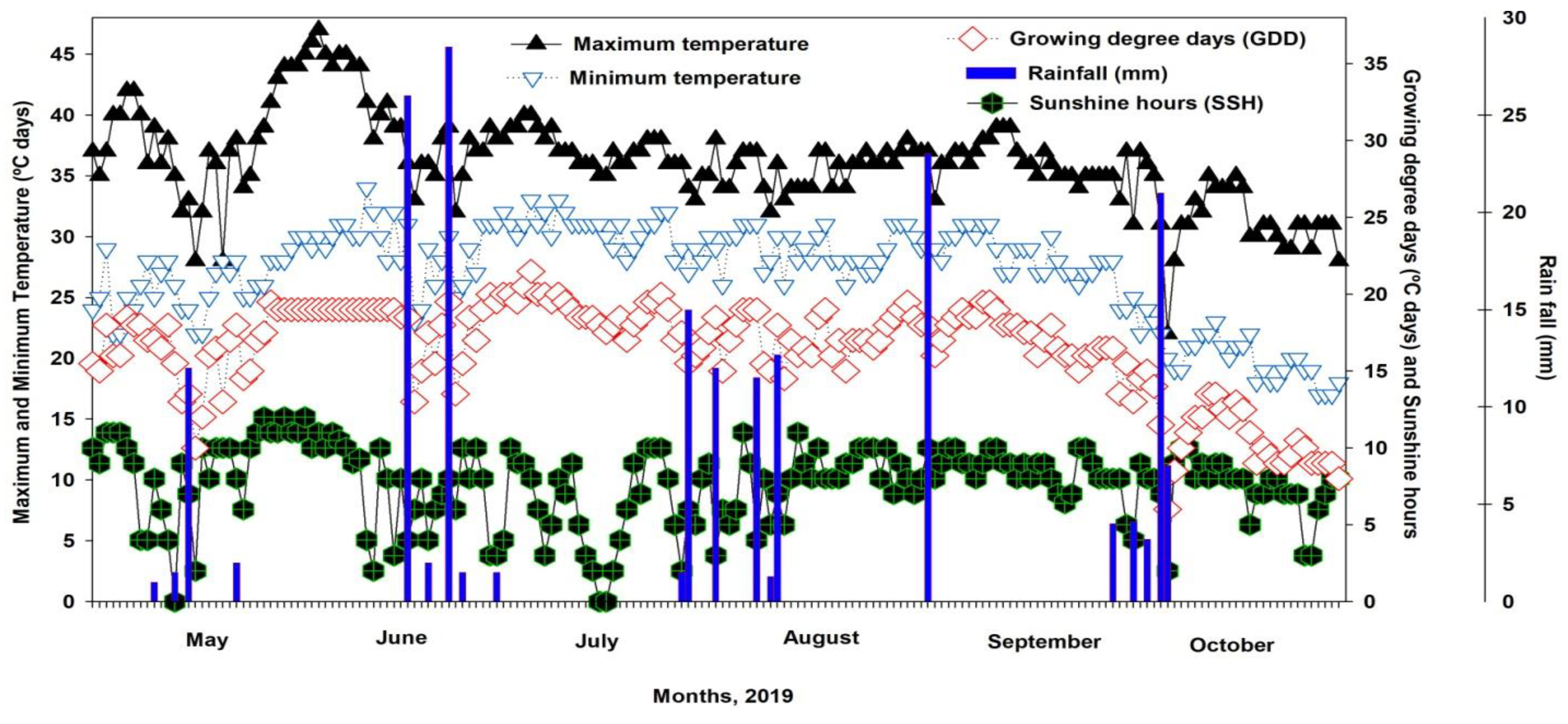
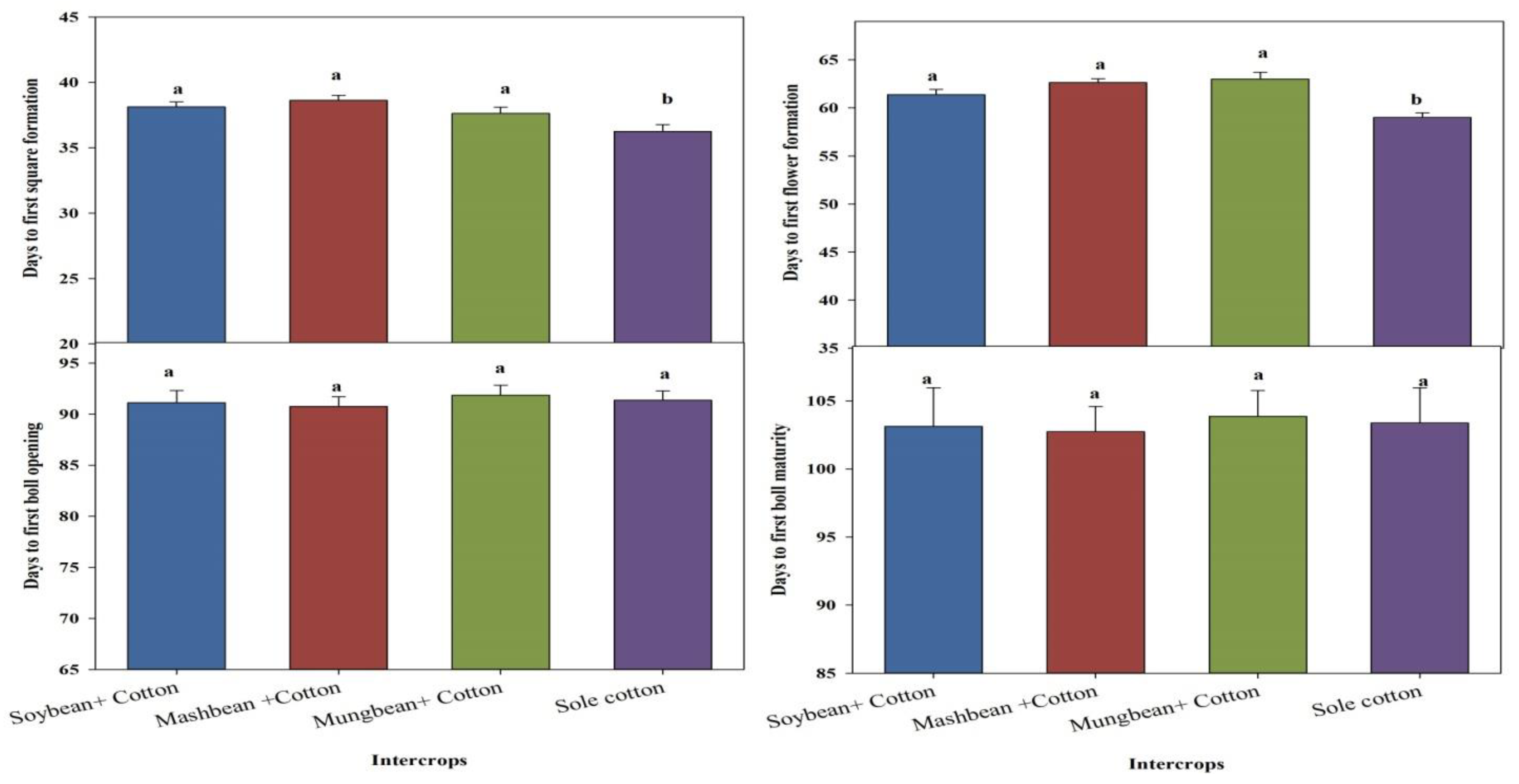
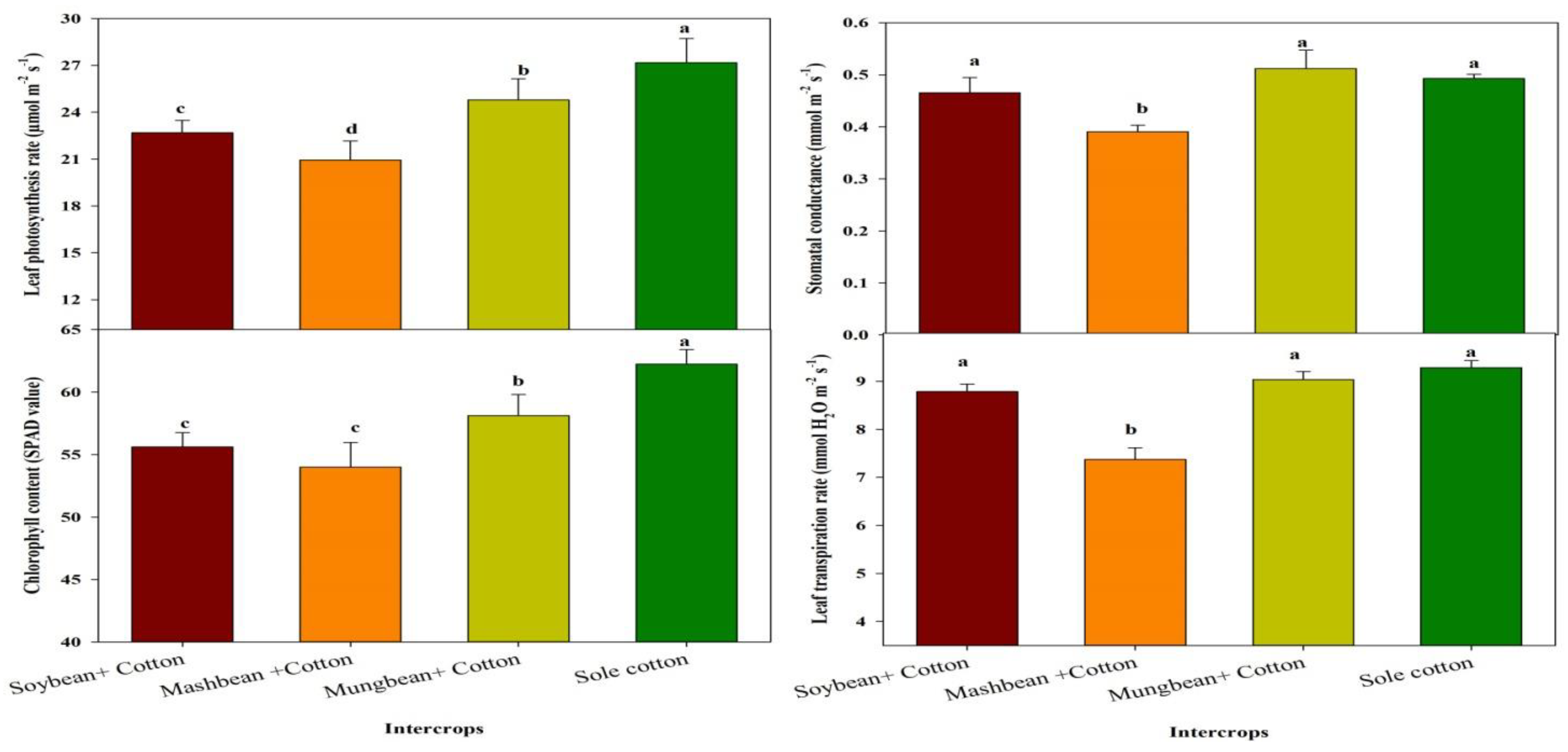
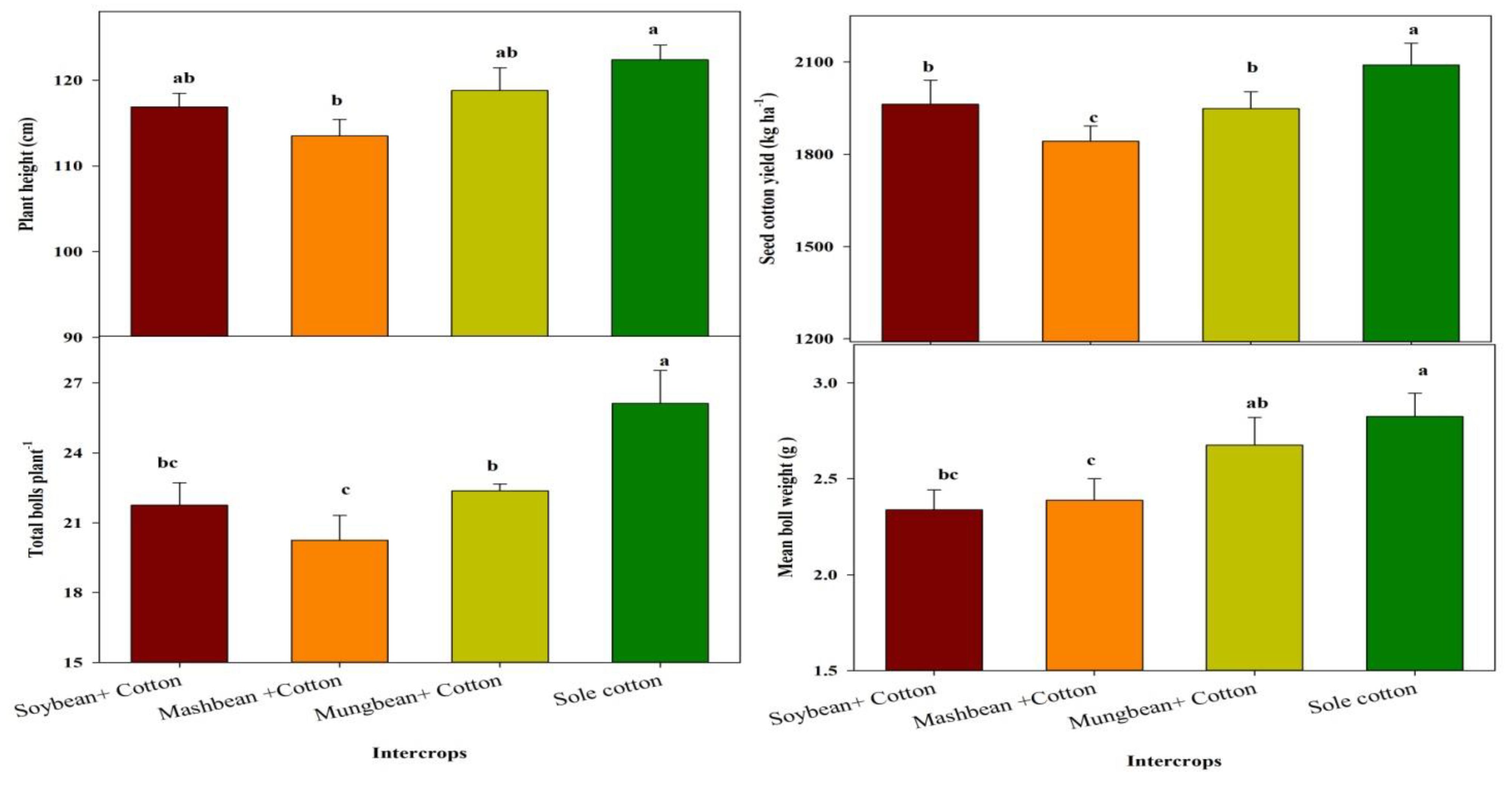
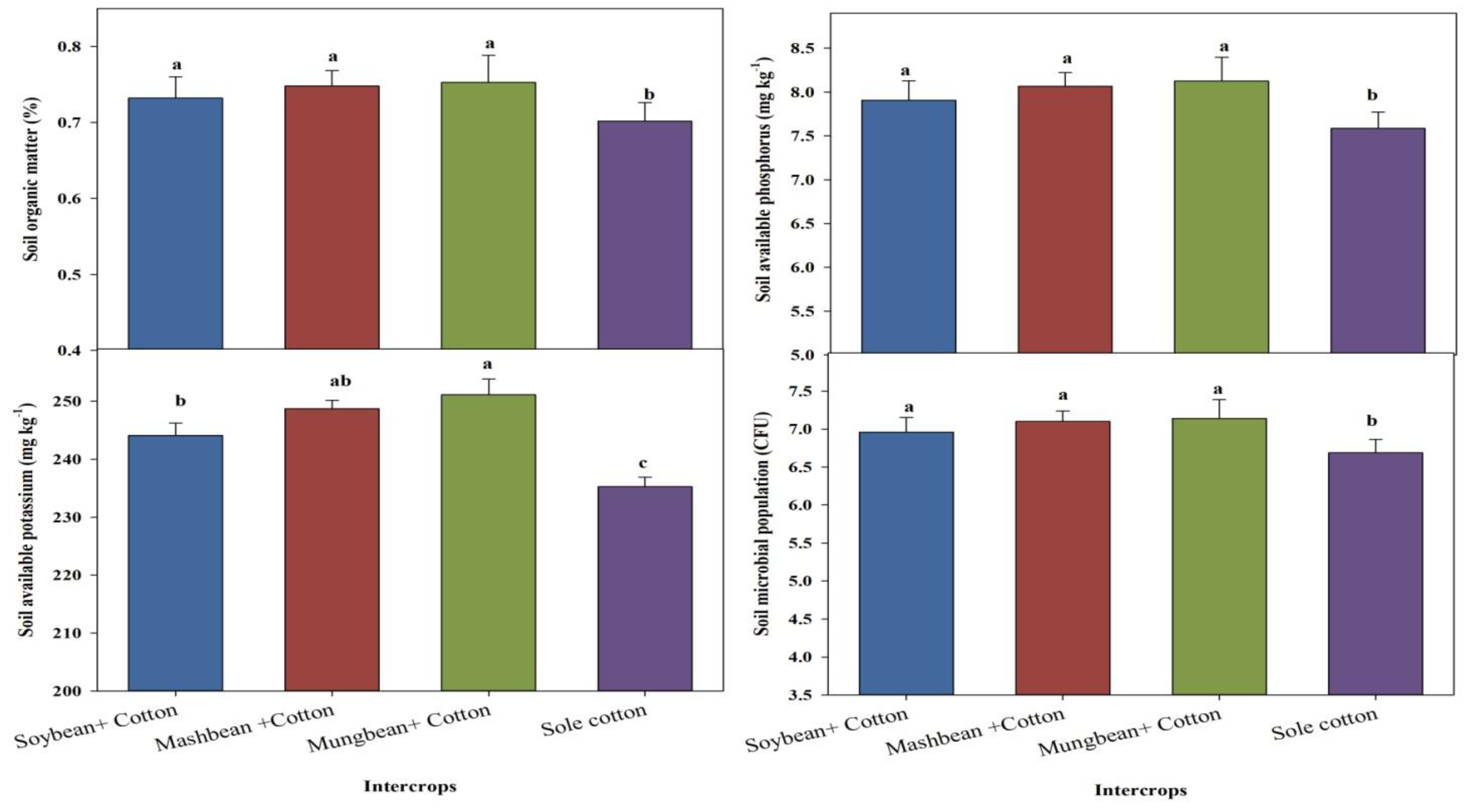
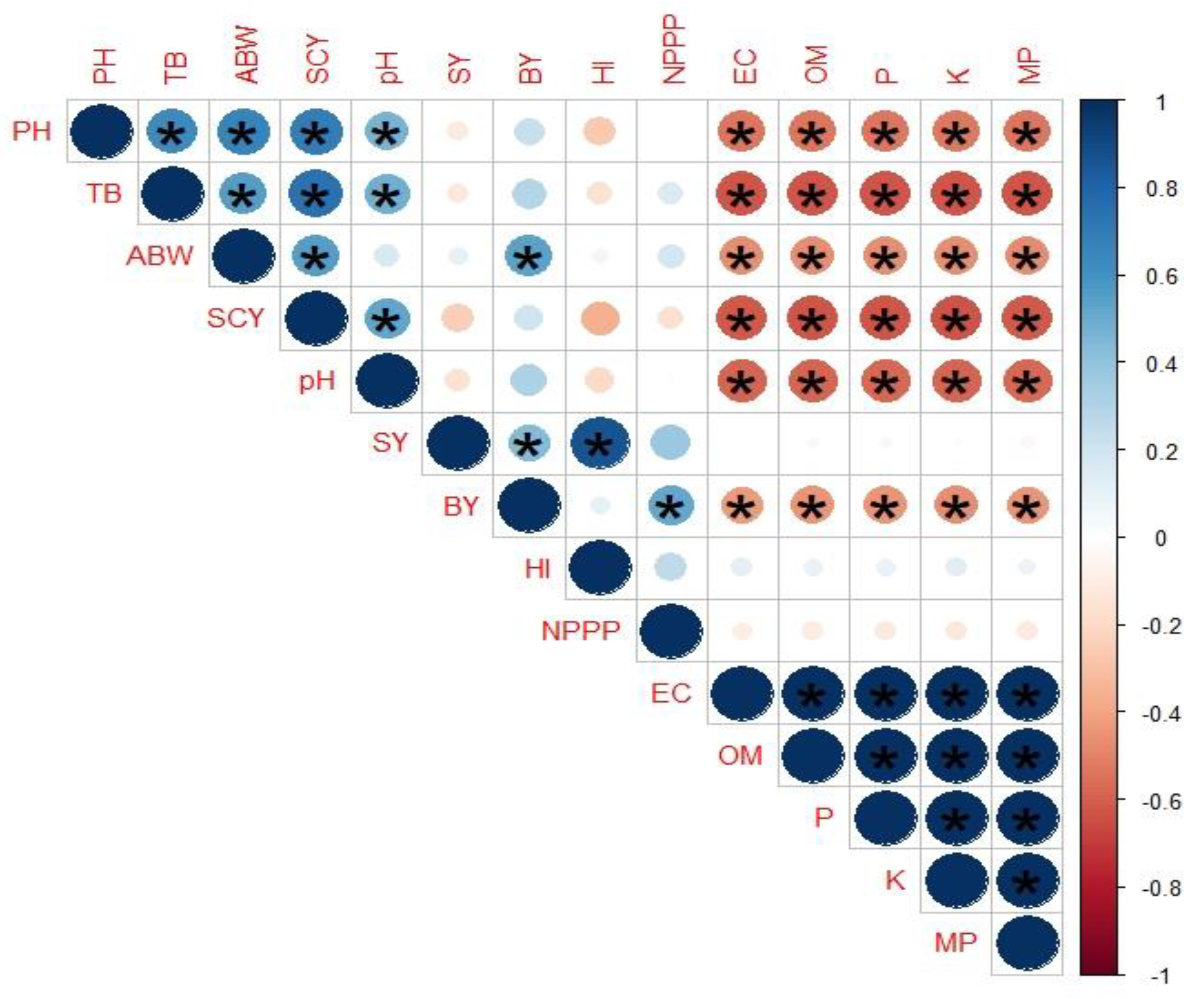
| Treatments | DSF | DFF | DBO | DBM |
|---|---|---|---|---|
| Tillage Systems (TS) | ||||
| CT | 36.9 a | 61.6 a | 90.0 a | 104.5 a |
| ZT | 38.4 b | 62.4 b | 92.6 b | 102.0 b |
| HSD (p ≤ 0.05) | 1.10 | 0.50 | 0.50 | 0.596 |
| Tillage Systems (TS) | NLTR | NLPR | SC | CHC |
| CT | 8.70 | 241 | 0.466 | 56.8 |
| ZT | 8.40 | 236 | 0.464 | 58.2 |
| HSD (p ≤ 0.05) | NS | NS | NS | NS |
| Tillage Systems (TS) | PH | TBPP | MBW | SCY |
| CT | 121 a | 22.9 a | 2.74 a | 2031 a |
| ZT | 116 b | 21.4 b | 2.37 b | 1889 b |
| HSD (p ≤ 0.05) | 4.00 | 0.30 | 0.21 | 80.0 |
| Tillage Systems (TS) | SOM | P | K | MP |
| CT | 0.75 b | 7.84 b | 245 b | 7.04 b |
| ZT | 0.77 a | 8.08 a | 253 a | 7.26 a |
| HSD (p ≤ 0.05) | 0.02 | 0.055 | 1.866 | 0.062 |
| Treatments | Pods Per Plant | Seed Yield (kg ha−1) | Biological Yield (kg ha−1) | Harvest Index (%) |
|---|---|---|---|---|
| Tillage Systems (TS) | ||||
| CT | 31.0 a | 163 a | 907 | 18.0 a |
| ZT | 28.0 b | 124 b | 867 | 15.0 b |
| HSD (p ≤ 0.05) | 0.90 | 4.10 | NS | 0.90 |
| Leguminous intercrops (LI) | ||||
| C1 | 31.0 a | 118 c | 866 b | 14.0 b |
| C2 | 26.0 b | 139 b | 841 b | 16.0 b |
| C3 | 32.0 a | 173 a | 950 a | 19.0 a |
| HSD (p ≤ 0.05) | 2.20 | 23.70 | 79 | 2.00 |
| TS | NS | ** | NS | ** |
| LI | * | ** | ** | ** |
| TS × LI | NS | NS | NS | NS |
| Treatments | Legumes Intercropping (LI) | ||
|---|---|---|---|
| Land Equivalent Ratio | |||
| Tillage Systems | C1 | C2 | C3 |
| CT | 1.06 | 1.04 | 1.11 |
| ZT | 1.04 | 0.99 | 1.06 |
| Area Time Equivalent Ratio | |||
| Tillage Systems | C1 | C2 | C3 |
| CT | 1.03 | 1.00 | 1.07 |
| ZT | 1.01 | 0.96 | 1.03 |
| Treatments | Aggressivity | ||
|---|---|---|---|
| ZT | Cotton | Intercrop | |
| Conventional tillage | |||
| C1 | 0.84 | −0.84 | |
| C2 | 0.76 | −0.76 | |
| C3 | 0.79 | −0.79 | |
| CT | Zero tillage | ||
| C1 | 0.80 | −0.80 | |
| C2 | 0.75 | −0.75 | |
| C3 | 0.74 | −0.74 | |
| Treatment | Variable Cost | Fixed Cost | Total Cost | Gross Income | Net Benefits | BCR |
|---|---|---|---|---|---|---|
| CTC1 | 5430 | 110,000 | 115,430 | 194,982 | 79,552 | 1.67 |
| CTC2 | 7274 | 110,000 | 117,274 | 190,485 | 73,211 | 1.65 |
| CTC3 | 4980 | 110,000 | 114,980 | 202,030 | 87,050 | 1.75 |
| CTC4 | 3500 | 110,000 | 112,000 | 192,240 | 80,240 | 1.71 |
| ZTC1 | 3430 | 110,000 | 113,430 | 172,575 | 59,145 | 1.47 |
| ZTC2 | 3274 | 110,000 | 115,274 | 178,740 | 63,466 | 1.54 |
| ZTC3 | 2980 | 110,000 | 112,980 | 181,480 | 68,500 | 1.67 |
| ZTC4 | 1120 | 110,000 | 111,120 | 183,870 | 72,750 | 1.57 |
Publisher’s Note: MDPI stays neutral with regard to jurisdictional claims in published maps and institutional affiliations. |
© 2022 by the authors. Licensee MDPI, Basel, Switzerland. This article is an open access article distributed under the terms and conditions of the Creative Commons Attribution (CC BY) license (https://creativecommons.org/licenses/by/4.0/).
Share and Cite
Saleem, M.F.; Ghaffar, A.; Rahman, M.H.u.; Imran, M.; Iqbal, R.; Soufan, W.; Danish, S.; Datta, R.; Rajendran, K.; EL Sabagh, A. Effect of Short-Term Zero Tillage and Legume Intercrops on Soil Quality, Agronomic and Physiological Aspects of Cotton under Arid Climate. Land 2022, 11, 289. https://doi.org/10.3390/land11020289
Saleem MF, Ghaffar A, Rahman MHu, Imran M, Iqbal R, Soufan W, Danish S, Datta R, Rajendran K, EL Sabagh A. Effect of Short-Term Zero Tillage and Legume Intercrops on Soil Quality, Agronomic and Physiological Aspects of Cotton under Arid Climate. Land. 2022; 11(2):289. https://doi.org/10.3390/land11020289
Chicago/Turabian StyleSaleem, Muhammad Faisal, Abdul Ghaffar, Muhammad Habib ur Rahman, Muhammad Imran, Rashid Iqbal, Walid Soufan, Subhan Danish, Rahul Datta, Karthika Rajendran, and Ayman EL Sabagh. 2022. "Effect of Short-Term Zero Tillage and Legume Intercrops on Soil Quality, Agronomic and Physiological Aspects of Cotton under Arid Climate" Land 11, no. 2: 289. https://doi.org/10.3390/land11020289
APA StyleSaleem, M. F., Ghaffar, A., Rahman, M. H. u., Imran, M., Iqbal, R., Soufan, W., Danish, S., Datta, R., Rajendran, K., & EL Sabagh, A. (2022). Effect of Short-Term Zero Tillage and Legume Intercrops on Soil Quality, Agronomic and Physiological Aspects of Cotton under Arid Climate. Land, 11(2), 289. https://doi.org/10.3390/land11020289










